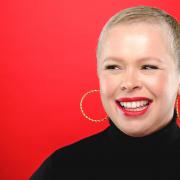Superstitions surrounding black cats are highlighted at Hallowe’en and this negative rhetoric has helped fuel a rehoming problem for certain coloured felines

According to Cats Protection, which has branches, adoption centres and shops across the county – including in Maidstone, Canterbury, Deal as well as Folkestone and Hythe – black and black-and-white cats are the least popular when it comes to rehoming and take 13 per cent longer to adopt than their more colourful counterparts.
Research by the charity shows the myth that black cats are unlucky seems to be taking hold with the younger generation, who are perhaps being influenced by American attitudes.
And a recent study showed that black and black-and-white cats account for almost half of all those taken in by the charity and spent on average 52 days in care, compared to around 33 days for silver tabbies.
The charity’s annual national black cat day on 27 October aims to help combat this issue by making people aware of the problem.
Adrian Ferne, manager for Cats Protection Bredhurst, between Gillingham and Maidstone, says around three quarters of cats currently needing a home at the adoption centre are black or black and white. He attributes this in part to superstition but mainly to people’s views on aesthetics.
“If there is a tabby, or a ginger, or a tortoiseshell or an oriental and then there’s a black or black or white cat, people tend to go for the others first because they are pretty. Occasionally it’s the case where someone has already had a black and white cat, it’s died and they would prefer a different colour the next time, but generally I would say it’s down to aesthetics.
“The worst-case scenario is if the cat is over 10, it’s black and white, it doesn’t like children, or dogs or other cats – straightaway it’s limiting its appeal and limiting the market of people who come to adopt. Quite often they will have children, other cats, or a dog – they may have all three. The older black and white ones are hardest to rehome,” he adds.

However, according to Adrian who has been at the Bredhurst centre for eight years, there is hope for black and monochrome cats.
“Two people have adopted nine-year old black cats recently and there are people out there for them. Marketing is important and occasionally we will do newspaper runs, but it’s having the finance to do that.
“We used to feature our cats in a newspaper every week and we would usually put black or black and white cats in there. But they don’t always photograph that well – when you speak to any designer and media person they say this.”
One such success story from the Bredhurst centre is that of Holly-Anne Hamilton and her black nine-year-old cat Dilly, whom she rescued just a few months ago, despite being tempted to adopt a tortoiseshell kitten instead.
Holly-Anne, from Lordswood near Chatham explains: “I went to Cats Protection with a very open mind but originally I really wanted a tortoiseshell cat, I’ve never had one before.
“But then I saw Dilly and she won me over. She’s a wonderful cat, she’s really friendly, really chilled out, laid-back and chatty.”
Holly-Anne has owned pet cats for 20 years and says that when her eldest cat died a few months previously the house seemed a bit empty. “I needed three cats, two didn’t seem enough,” she admits.
“One of my other cats is black and white, he’s called Fenix and the other one is a pedigree British shorthair called Dizzy.
“I said to myself after I splashed out on my pedigree that my next cat would definitely be a rescue one. So when my eldest cat passed away in March we decided to go down to the Cats Protection to see what they had. Our biggest criteria was that they could get on with the other cats. Dilly was there, and the tortoiseshell kitten.
“We went home, thought about whether we wanted a kitten or an older cat – my other two cats are two and five – and my mind kept coming back to Dilly. The fact that she is a little bit older, is so beautiful, so friendly and so chatty; I just had to go back and get her.”
Holly-Anne believes there are many benefits to adopting an older cat. “Anyone who has had kittens knows they can be quite hard work, they just run around all over the place, whereas Dilly, being older, is chilled out and laid back. She still has a bit of a run around but mostly she is quite content to sit on the sofa and have a stroke.”
Dilly is Holly-Anne’s first black cat and she says she never had a problem with her colouring.
“I think it’s the whole superstition thing that people are concerned about isn’t it? There’s also the thought that if black cats are out at night they are not as visible. You do get a bit concerned about that and I’ve not let Dilly out at night yet – she’s just out during the day and as we have only had her a few months.”
Holly-Anne, who has suffered with illness, works from home and with the cats for company she says she doesn’t feel that she is by herself all day. “My cats help to keep me calm and give me a reason to get up in the morning, I like feeding them and making sure they are alright. Having cats is very calming.
“In the winter, because my desk is in my bedroom, I’ve usually got one on my desk and the others on the bed. There’s usually a cat within stroking distance wherever I am in the house.”
Holly-Anne thinks the black cat day is a good idea because she noticed most of the cats at the Bredhurst centre were either black or black and white. “It did shock me, although I haven’t had a black cat before, I’ve had black and white and mine is amazing, he follows me all around the place. Each cat has its own personality and its colour makes no difference to that.”
Adrian explains that the Bredhurst centre has undergone a major refurbishment in the past year which has seen an increase in efficiency and 406 cats being re-homed in the first six months of this year – an increase of 103 cats compared to the same period in 2015.
When potential cat owners come through the centre’s doors he always encourages them to go for character rather than the cat’s appearance.
“Quite often it’s the cat that choses the person rather than the other way around.
“If people come here for a cat and it starts being very affectionate their hearts just melt.”
Find out more
For more information about the charity and its black cat event visit www.cats.org.uk/black-cats.



























